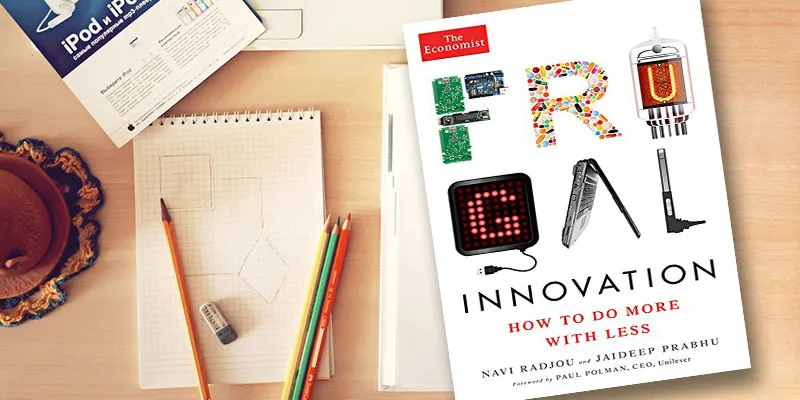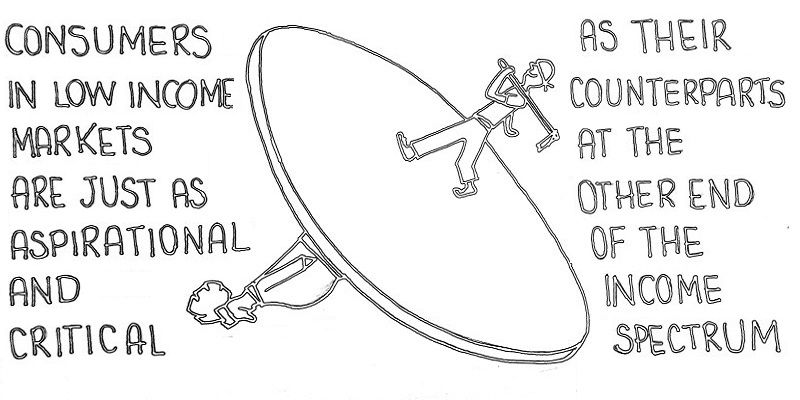Frugal Innovation: six tips for doing better with less
The disruptive rise of the global startup movement and the power of the digital GAFA giants (Google, Apple, Facebook, Amazon) are causing traditional industry leaders to search for new approaches to innovation.

For example, AirBnB’s founders had no experience in the hotel industry, but the site now ranks No.5 in room nights filled worldwide - more than the Hilton chain. Car-sharing site BlaBlaCar transports more passengers a month in Europe than the EuroStar train. For small and large companies, key emerging success factors are efficiency, speed and agility of their innovation engines.
A clear framework of six steps for innovation, backed with dozens of insightful examples, is offered in the thought-provoking and practical book, ‘Frugal Innovation: How to do more with less’ by Navi Radjou and Jaideep Prabhu.
Their earlier best-seller focused on frugal innovations in emerging economies: ‘Jugaad Innovation: A Frugal and Flexible Approach to Innovation for the 21st Century’ (see my book review and author interview).
Consumers today want companies to offer quality and value as well as have a sense of purpose and social mission. Companies must therefore figure out how to do better with less rather than do more with less, begins Unilever CEO Paul Polman in the foreword. The combination of global R&D expertise along with frugal ingenuity in emerging economies can be a winning formula.
The online companion of Frugal Innovation offers links to videos, articles, Twitter feeds, and a newsletter. The book is a must-read for all those in the fields of strategy and innovation, and for startups who want to understand the mindset of potential corporate customers.
Here is my takeaway on the six principles and recommendations made by the authors:
Principle 1: Engage and iterate
Earlier models of top-down R&D are time consuming, inflexible, complex, and expensive, and can alienate customers and cause excess environmental waste. Though 90 per cent of corporate R&D spend occurs in the West and Japan, an estimated 80 per cent of new products fail at launch. A better solution would be a market-focused, agile R&D model, starting off with good-enough solutions based on active and immersive customer involvement. Iterative prototyping and high-speed innovation call for new kinds of titles and incentives.
Examples: Intuit’s ethnographic observation of customer product usage at home; use of crowdsourcing site SoapBox by Cisco and GSK Canada; Affinova tools for customer feedback and product validation; customer experimentation with Caterpillar prototypes; use of light sensors by Philips Lighting; market validation for new research in Dupont; cross-functional teams at Lego; French railway company SNCF’s TGV Labs for productivity apps; placement of MNC R&D teams in emerging economies like India, China and Brazil.
Principle 2: Flex your assets
New materials, manufacturing tools, and supply chain techniques can reduce the supply-demand gap and improve distribution and procurement. These range from carbon fibre and 3D printers to micro-factories and supply chain analytics.
Examples: Smaller nimbler plants of Volkswagen closer to local customer bases; 3D printing tools by Autodesk; crowdsourcing site Quirky’s rapid generation of products; creation of the GE Distributed Power unit; Unilever’s Project Shakti door-to-door sales teams in rural areas; SCM/CRM integration by Cemex.
Principle 3: Create sustainable solutions
Environmental sustainability is not an optional CSR channel but an essential strategy for long-term success. Consumers and regulators are demanding more eco-friendliness and accountability from companies. This has led to the rise of cradle-to-cradle solutions for recycling and upcycling, going beyond the ‘circular economy’ to the ‘spiral economy.’ A new trend is also the rise of the ‘sharing economy.’ Sustainability should be built right into the R&D phase, and should be promoted as cool and aspirational.
Examples: Unilever’s Sustainable Living Plan; Tarket’s closed-loop water circuits in carpet factories and take-back programme for recycling; Method Cleaner’s use of ‘green chefs;’ FIAM’s creating of artistic works from waste glass; sharing homes (AirBnB); sharing cars (BlaBlaCar, EasyCar); sharing parking spaces (ParkAtMyHouse).
Principle 4: Shape customer behaviour
In addition to changing their own goals and structures, companies can also actively engage with their customers to promote sustainable living. Visualisation tools, self-monitoring, gamification, social comparison, social learning and storytelling are useful techniques here to motivate, nudge, inspire, and empower customers.
Examples: Nest’s monthly energy reports and device control apps; reduction of environment impacts of products by Tesco; HubCab app to visualise cab sharing; health indicator monitoring via Jawbone; Progressive’s use of telematics to track and reward good drivers; modular and leasable carpets by Interface; financial reporting tools by Simple Bank.
Principle 5: Co-create value with prosumers
Consumers today are transformed into prosumers who want meaningful brands conversations and personalised solutions. The rise of the ‘horizontal economy’ includes the maker movement of tinkerers, collective buying sites, P2P sharing platforms, and crowdfunding hubs. Companies should pursue a strategy of co-discovery, co-development, co-marketing, co-branding and co-marketing with prosumers. A useful categorisation of such customers is dreamers, validators, ideators, makers, evangelists, sales agents, and fixers.
Examples: Submission of customer ideas for product development by retailer Auchan and yogurt leader Danone; manufacturing workspaces for customers in ADEO retail outlets; 3D printing services of ShapeWays; hand-made items for sale on e-commerce site Etsy; rise of FabLabs and TechShops; spread of Arduino and Raspberry Pi; crowdfunding platforms KickStarter and Indiegogo who promote the ‘middle class Medici.’
Principle 6: Make innovative friends
The need for hyper-collaboration calls for increasing skills in big companies to partner with suppliers, competitors, government, hackers, tinkerers and startups. (Also see my article 15 innovation tips: how large corporations can successfully engage with startups.) Companies need innovation brokers who understand the language of the organisation, its creative partners and customers. Corporations need to become more agile and not just file patents but monetise them.
Examples: Creation of the GE Ventures fund for Silicon Valley startups; Renault learning frugal techniques from its Chennai plant to create low-cost Dacias cars for Europe; industrial symbiosis and by-product synergy between large manufacturers like Chaparral Steel and Texas Industries; AmEx’s frugal solutions BlueBird and Serve for low-income Americans; Pearson’s Catalyst for Education initiative to engage with ten startups a year; Ford’s TechShop engagement with tinkerers; Google’s open-source strategy with Android; Accor’s speed-dating events in France, Silicon Valley and Singapore to bringing together hotel managers and SMBs.
The concluding chapter ties these principles together by showing that such impacts can be brought about only by bold leadership, setting of inspirational goals, choosing measurable targets, reinventing business models, and cultural change management. Examples here include Marks & Spencer’s articulation of Plan A for green metrics (‘there is no Plan B’); Aetna’s Medicity health information exchange and Health Innovation Labs for customer engagement; IBM’s new R&D lab in Kenya; Pepsico’s Global Value Innovation Centre (GVIC) in India; Siemens’ SMART product realignment in China and India.
But 80 per cent of companies in mature economies do not yet have a frugal innovation strategy, and have a lot to learn from the ‘frugal forerunners’ described in the book. Broad trends to watch include the feedback-rich economy that is “restorative and regenerative rather than extractive,” according to the Ellen MacArthur Foundation. In the new customer-led world order, “velocity, synergy, empathy and involvement” are standard, adds Kevin Roberts, CEO Worldwide, Saatchi & Saatchi.
In sum, authors Radjou and Prabhu have done a great job of showing how innovation is now a global endeavour involving large and small firms, mature and emerging economies, tool and talent approaches, both in the West and East.
About the authors:
Navi Radjou (Twitter: @NaviRadjou) is an innovation and leadership advisor based in Silicon Valley. He won the 2013 Thinkers50 Innovation Award and spoke at TED Global 2014. He is a regular contributor to Harvard Business Review online. Previously, he served as Vice President at Forrester Research in Boston and San Francisco. An Indian-born French national, Navi lives in Palo Alto, California.
Jaideep Prabhu (Twitter: @JaideepPrabhu) is a writer, consultant, and Director of the Centre for India & Global Business at Judge Business School, Cambridge, specialising in marketing, innovation, strategy, and international business. He is a member of the editorial boards of the Journal of Marketing, the Journal of the Academy of Marketing Science, the International Journal of Research in Marketing Science, and the Journal of Management Studies.











